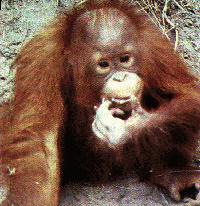The Orang Utan

The orangutan (Pongo pygmaeus) is a large red-haired ape that has an appealing human-like face. Its name has been translated as "forest man" in Malay. Males and females differ dramatically in size and appearance. The female stands 3 1/2 feet tall and weighs about 110 pounds, while the male stands 4 1/2 feet tall and weighs 200 pounds or more. A dominant male also develops large cheek pads or flanges and a throat pouch. The hands and feet of the orangutan are almost identical, and well adapted for grasping and hanging from tree limbs. Orangutans are often referred to quite accurately as being "four-handed."
Orangutans are found on the island of Borneo, which is divided between the nations of Malaysia and Indonesia, and on the Indonesian island of Sumatra. Their historical range extended much further throughout Indochina. However, the existing sub-species, the Bornean and Sumatran orangutans, have been geographically separated for over 1 million years with no route of gene flow between the two.
Large tracts of mature rainforest are needed to support the orangutan. It is arboreal and spends most of its life high in the forest canopy where it builds a new sleeping nest each night.
Fruit makes up the majority of an orangutan's diet, which also includes bark, flowers, honey and occasional insects. Fruit-bearing trees benefit from the presence of orangutans as they disperse seeds throughout the forest in their droppings.
Orangutans are largely solitary animals because of the large home range each requires. Orangutans do have the potential for strong social attachments, which is expressed under appropriate conditions. Otherwise, the scarcity of fruit and the limited amount of weight the treetops will bear precludes the formation of social groups in the wild. Loud daily calls from dominant males alert females that are ready to mate of his presence. The female seeks him out for breeding, but returns to a solitary life after a few days. The female has one dependent infant, which she then nurses for up to seven years. Unlike many animals, orangutan infants have few instinctive behaviors and must learn from watching their mother.
Logging and other human encroachments are rapidly destroying the rainforest where orangutans live. They are also frequent victims of poaching and smuggling for the pet trade. Poachers shoot the mother and take the infant to sell.
While population estimates are difficult in the dense forest, there are thought to be 6,500 - 7,500 orangutans in Sumatra and 12,000 - 13,000 in Borneo. It is listed as an endangered species by the U.S. Fish and Wildlife Service and the IUCN Red Data Book. Orangutans are protected by law in Indonesia and Malaysia.

 The Black Rhino
The Black Rhino Get your own Free Home Page
Get your own Free Home Page